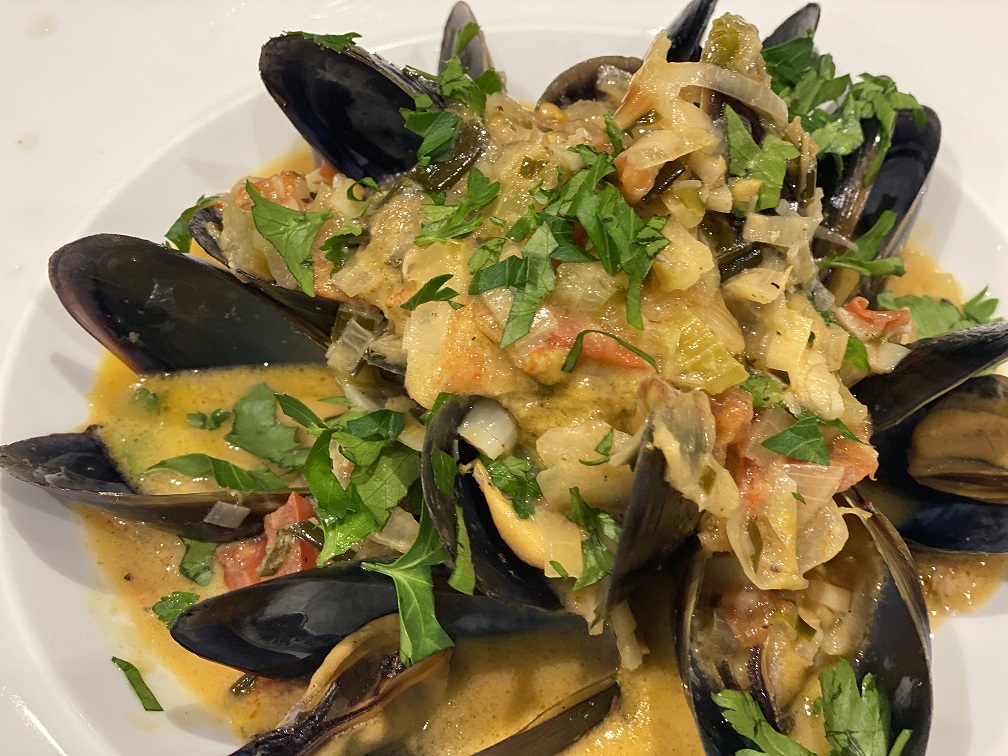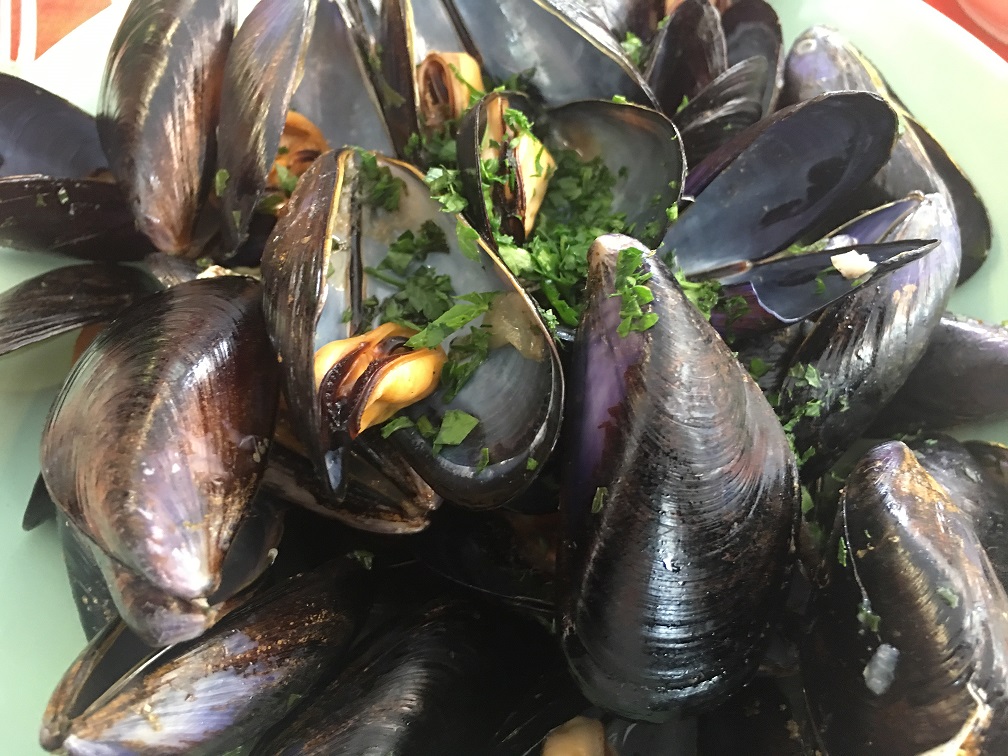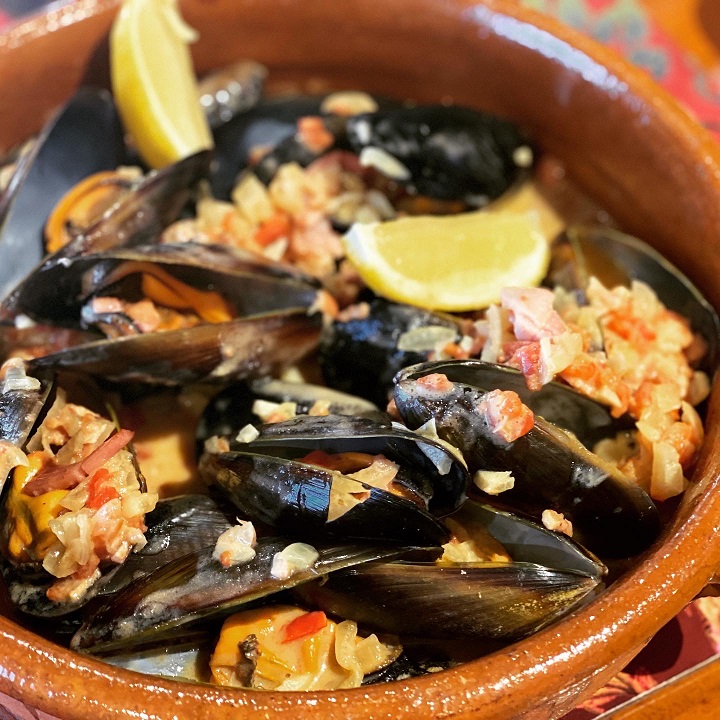Moules Marinière is one of the best-known classic French mussel dishes. The recipe hails from the wives of French sailors living along the northwest coast of Brittany, where most of France’s mussel catch is harvested.
It is a typical French provincial bistro dish, in that these Bretagne sailors’ wives could afford to make a nutritious, quick, easy and inexpensive meal with their local mussels, that were readily available in their coastal location.
Interestingly, Moules Marinière is mainly eaten when out at restaurants, which is a shame as it is so easy and cheap to make at home. When in France, one of our first stops on the way to the barge, is a lunch at a little country bistro, where we order a ‘moules et frites’, a simple moules marinière.
For the classic, simple ‘Moules Marinière’, it involves cooking the mussels with white wine and water; I am sure those Bretagne sailors’’ wives would have used water only. Add a bouquet garni of bay leaf, parsley, celery stalk, thyme and peppercorns, plus a diced onion and 2 or 3 cloves of garlic, also diced. The mussels are cooked in a large pot, as below in my recipe, and, when cooked and open, they are put into individual, large soup bowls; cream can be added to the cooking liquor and then it is strained over the mussels, and, there you have it, a very simple lunch of mussels in a mussel broth.
Recipes for ‘Moules Marinière’ appear in many famous cookery books including those of Elizabeth David, Julia Child, Rick Stein, Paul Bocuse, Phillipe Mouchel and MFK Fisher; there are countless others!
There are therefore many versions of Moules Marinière. Some add a beurre manié, of 1 tbsp of flour and 1 tbsp butter worked into a paste to thicken the liquid, others make a roux with butter and flour, cooked first in the pan with the onion, celery, garlic and white wine. For lunch, I frequently make this simple, classic moules marinière version.
For dinner, I prefer my recipe here for a more sustaining, hearty meal, as it includes a mussel and vegetable purée.
Serves 2 as a substantial main course
Ingredients:
For the mussel and vegetable base
4 tbsp olive oil
40g butter
1 large brown onion, chopped
½ leek, finely sliced, white stem and some green leaves as well
3 garlic cloves, finely chopped
1 x stick celery, finely sliced, optional
¼ – ½ tsp dried chilli flakes or more to taste, optional
6 vine-ripened tomatoes, and chopped, optional
250ml dry white wine
250ml fish stock
250ml cream, more if necessary
4 tbsp parsley, roughly chopped
Mussels
1kg mussels – allow 500g per person
350ml white wine; enough to cover the base of pot by 1-2cm; or, use half water and wine
6 peppercorns
Bouquet Garni
1 bay leaf
4 parsley stalks
3 celery tops with leaves
3 sprigs thyme
Garnish
3 tbsp garlic cloves, finely chopped
Extra sprinkling of finely chopped parsley
Sea salt and freshly ground black pepper
1 lemon cut into wedges
Method:
To make the mussel and vegetable base: take a large pot and add the olive oil, butter, onion and leek, and cook over medium to high heat for about 10 minutes, until softened and luscious. Add the garlic, celery, chilli flakes, tomatoes and cook another 10 minutes, add the wine, fish stock, cream, parsley and simmer for 5 or so minutes to reduce and thicken. Put to one side until ready to cook mussels.
To prepare the mussels: discard any mussels with broken shells, and those that won’t close when tapped or lightly squeezed.
Remove the tough, fibrous beards, called the byssus thread, that protrude from between the tightly closed shells; these ‘beards’ secure itself to hard surfaces. Remove the ‘beards’ by giving them a sharp tug towards the hinge end of the mussel. If necessary, scrub the shells and knock off any barnacles, although these days mussels are quite well cleaned before we buy them.
To cook the mussels: Take a large pot, one large enough to hold the kilogram of mussels, add the white wine, black peppercorns, and bouquet garni of bay leaf, parsley, celery and thyme. Turn up the heat, and when very hot and the wine is boiling, add the mussels, all at once. Cover with a tight-fitting lid, give the pot a shake to distribute the heat, and cook for a minute or two, shaking the pot every now and again, so the mussels are all moved over the source of the heat.
Lift the lid, quickly, to check the mussels, and as soon as they open, remove them with long handled tongs; place them into a large bowl. Replace the lid and return the pot to the heat and repeat until all the mussels have opened. Discard those mussels that have not. Drain the cooking juices through a fine sieve, strainer or some muslin cloth and add to the base.
Remove half the mussels from their shells and set aside, ready to add to your base. The remaining mussels in the shells are added on top of the base.
To assemble: take 2 smallish ladles of the unpuréed base, set aside and keep warm. This will be used to pour over the mussels in their shells, as a garnish for serving.
Add the shelled mussels to the rest of the base and purée them with a stick blender until smooth. Taste and season; add some extra water, wine or cream to your liking. Reheat if necessary.
Pour the puréed base into your 2 large serving soup bowls. Place the remaining mussels in their shells, attractively on top and spoon over the unpuréed base.
Garnish with chives and parsley.
Serve with crusty, sourdough bread and lemon wedges.
The French, pluck each mussel from its shell with another shell used as a pincer.
- Using the shells as pincers to eat mussels, as the French do
- Simple Moules Marinière
- Moules bistro lunch in Rouen
- Another Moules Marinière
Add images










